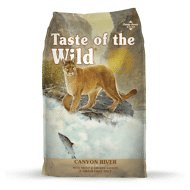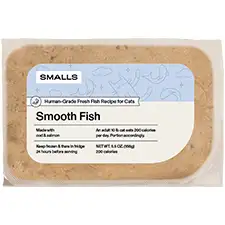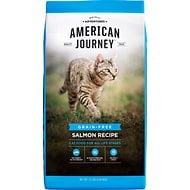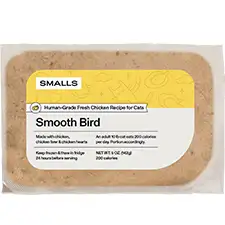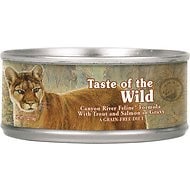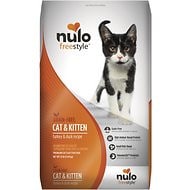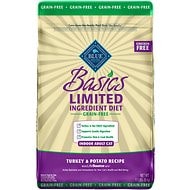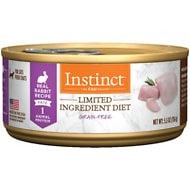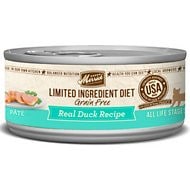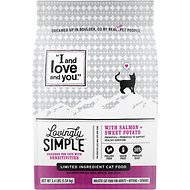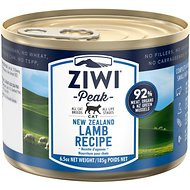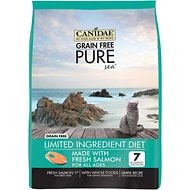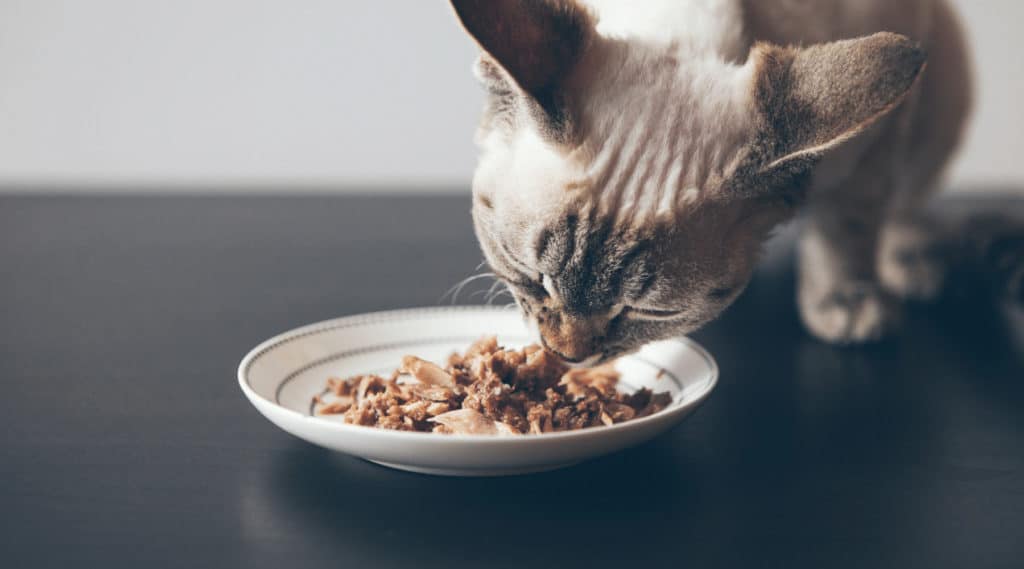Contents
- What Is The Best Cat Food Without Chicken?
- What You Need to Know About Chicken in Cat Food
- What’s the Problem?
- What Are the Alternatives?
- What Should You Look for in a Healthy Cat Food?
- How Do We Make Cat Food Recommendations?
- The 10 Best Cat Foods Without Chicken
- Smalls Smooth Fish Fresh Cat Food Delivery
- Taste of the Wild Canyon River Grain-Free Dry Food
- American Journey Salmon Recipe Grain-Free Dry Food
- Nulo Freestyle Grain-Free Turkey & Duck Cat & Kitten Recipe
- Blue Buffalo Basics LID Turkey & Potato Indoor Mature Recipe
- Instinct by Nature’s Variety Limited Ingredient Diet Grain-Free Real Rabbit Recipe Canned Food
- 4 More Top-Rated Limited Ingredient Cat Foods without Chicken
- Frequently Asked Questions
The most popular cat food recipes on the market tend to be the most affordable. Affordable prices for consumers are a by-product of lower production costs for manufacturers. Because proteins are the most expensive ingredients in cat food, a lower price tag often means lower quality.
Chicken is one of the most affordable proteins for cat food manufacturers. Just because it is affordable, however, doesn’t mean it’s low-quality. Fresh chicken and even chicken meal provide a nutritious source of animal-based protein, though you do need to be wary of chicken and poultry by-products. In some cases, you also have to worry about cat food allergies to chicken. They are more common than you might want to believe.
| Our 2023 Picks: Best Cat Foods Without Chicken | ||
|---|---|---|
| Smalls Fresh Bird Human Grade Cat Fod | Our Top Pick
| VIEW LATEST PRICE → |
| Taste Of The Wild Canyon River |
| VIEW LATEST PRICE → |
| American Journey Salmon |
| VIEW LATEST PRICE → |
| Nulo Freestyle Grain-Free Turkey & Duck |
| VIEW LATEST PRICE → |
| Blue Buffalo Basics LID Turkey & Potato |
| VIEW LATEST PRICE → |
| Instinct by Nature’s Variety Limited Ingredient Diet |
| VIEW LATEST PRICE → |
| Merrick Limited Ingredient Diet Grain-Free |
| VIEW LATEST PRICE → |
| I and Love and You Lovingly Simple LID |
| VIEW LATEST PRICE → |
| Ziwi Peak Lamb Recipe Canned Cat Food |
| VIEW LATEST PRICE → |
| Canidae Grain-Free LID PURE Sea |
| VIEW LATEST PRICE → |
In this article, you’ll learn everything you need to know about chicken in cat food, the good and the bad. We’ll also briefly cover the subject of chicken allergies in cats and talk about some alternative protein options. From there, we’ll tell you what to look for in a healthy cat food and give you our top picks for the best chicken free cat food.
What Is The Best Cat Food Without Chicken?
- Smalls Smooth Fish Fresh Cat Food
- Taste of the Wild Canyon River Grain-Free
- American Journey Salmon Recipe Grain-Free
- Nulo Freestyle Grain-Free Turkey & Duck
- Blue Buffalo Basics LID Turkey & Potato
- Instinct by Nature’s Variety Limited Ingredient
- Merrick Limited Ingredient Diet Grain-Free
- I and Love and You Lovingly Simple LID
- Ziwi Peak Lamb Recipe Canned Cat Food
- Canidae Grain-Free LID PURE Sea
What You Need to Know About Chicken in Cat Food
Adult cats require a minimum of 26% protein in their diets and kittens require even more, around 30%. Keep in mind that these numbers are absolute minimums – the more protein the better.
Any cat food worth its salt will list a high-quality source of animal protein as the first ingredient. Many of the most popular cat foods on the market are made with chicken as a main ingredient. It’s an affordable protein option for pet food manufacturers and a familiar ingredient for pet owners. There are different forms of chicken used in pet foods, some good and some bad.
Here are some quick definitions you should know:
- Chicken – The clean combination of flesh and skin with or without accompanying bone, derived from the parts or whole carcasses of chicken or a combination thereof, exclusive of feathers, heads, feet, and entrails.
- Chicken Meal – Chicken (as defined) that has been ground or otherwise reduced in particle size.
- Chicken By-Product – The clean parts of the carcass of slaughtered chicken, such as necks, feet, undeveloped eggs, and intestines, exclusive of feathers, except in such amounts as might occur unavoidable in good processing practice.
- Chicken By-Product Meal – The ground, rendered, clean parts of the carcass of slaughtered chicken, such as necks, feet, undeveloped eggs, and intestines, exclusive of feathers, except in such amounts as might occur unavoidable in good processing practice.
As you can see, chicken and chicken meal are the same thing – the only difference is the form in which it was received from the supplier. The same is true for chicken by-products and chicken by-product meals. The thing to remember is that some of the things that make up chicken by-products like feet are not inherently bad. They may sound unappetizing to you, but they are little more than bone covered in a small amount of muscle, perfectly acceptable for your cat to eat. Other by-products including eggs, intestines, and organs are all rich in nutrients as well.
The problem is that the quality of chicken by-products can vary greatly. There is no guarantee as to what proportion is included of each, so some by-products might contain mostly bone while others contain a better balance. It’s important to note as well that unless the ingredient is generically labeled “poultry by-product” it should not contain diseased, dying, or dead animals. It should only contain the meat and by-products of slaughtered poultry (chicken or turkey, as named).
What’s the Problem?
By now it should be evident that chicken itself is not a bad ingredient in pet food – even chicken by-products can be perfectly fine. The problem is that chicken is one of the most common cat food allergies. Cats can technically develop an allergy to any ingredient they eat, but proteins like chicken, beef, and fish are the most common culprit.
If your cat has been diagnosed with food allergies, you may want to conduct a feeding trial to identify the cause of the problem. If your cat is currently eating chicken cat food, choosing a new cat food that doesn’t contain chicken ingredients is a great place to start. You’ll need to stick to the chicken free diet for 8 to 12 weeks to see if your cat’s symptoms resolve and, if they do, you’ll have a pretty good idea that chicken was the problem. Read more about feeding trials in the FAQs below.
What Are the Alternatives?
If you’re feeding your cat a product that contains chicken by-products, you need to ask yourself whether it’s the chicken that is the problem or the quality of the chicken. Some cats are sensitive to low-quality ingredients like by-products but are able to tolerate real meat just fine. In either case, you may be wondering if there are any other protein options to look for instead of chicken.
Here are some alternative proteins to chicken you might consider:
- Beef
- Pork
- Lamb
- Turkey
- Salmon
- Whitefish
- Tuna
- Duck
- Venison
- Bison
Making sure your cat’s food is chicken-free is important, but you also need to know whether it’s going to provide for your cat’s nutritional needs on the whole. Read on to learn what to look for in a healthy cat food and to see our top picks for the best chicken free cat foods.
What Should You Look for in a Healthy Cat Food?
The most important thing you need to remember about your cat is that he is an obligate carnivore. This means that his body is designed to digest and absorb nutrition most efficiently from animal sources – cats have no biological need for carbohydrates. Protein should be the foundation of your cat’s diet, but it doesn’t have to come from chicken. Double check the list of alternatives from the previous section and keep them in mind when you start shopping around for chicken free cat food.
Here are some things to look for in a good cat food:
- High-quality animal protein. Protein should be the first ingredient in your cat’s food, no exceptions. More than one source of protein can be good too as long as it’s mostly animal protein and not plant proteins like pea protein, potato protein, or alfalfa meal.
- Healthy animal-based fats. Fat provides a concentrated source of energy for cats as well as essential fatty acids like omega-3s. Animal-based sources like chicken fat and fish oil are best.
- Limited content of digestible carbohydrates. Cats have no biological requirement for carbohydrates in their diet and a limited ability to digest them. Any carbs in your cat’s food need to be highly digestible and nutritious like whole grains, vegetables, and fruits.
- Complete and balanced nutrition. Your cat’s diet needs to contain minimum amounts of certain nutrients, so make sure the recipe you choose is labeled complete and balanced by AAFCO.
- No artificial additives. Artificial colors, flavors, and preservatives don’t belong in your cat’s food. It’s really that simple.
Now that you know what to look for in a healthy cat food, you’re ready to start shopping! Before you do, however, we want to tell you how we make our cat food recommendations so you know whether you can trust the picks we list below.
How Do We Make Cat Food Recommendations?
We would never recommend something to you if we weren’t completely confident in it. We would gladly feed our own cats any of the products we recommend. But what makes a product worthy of our approval? First and foremost, it must adhere to AAFCO food nutrient profiles which ensure that the product meets your cat’s minimum nutritional requirements. From there, we look at the ingredients list to ensure that those nutrients come from high-quality, digestible natural sources.
Here are some general requirements for a cat food recipe to receive our stamp of approval:
- A source of high-quality animal protein as the first ingredient
- At least 30% crude protein for kittens and at least 26% for adults
- A minimum of 9% crude fat for kittens and adults
- A balance of omega-3 and omega-6 fatty acids, primarily from animal sources
- A rich blend of nutrients from natural sources and supplements, as needed
- Limited carbohydrate content from digestible sources (like whole grains and veggies)
- No low-quality fillers, by-products, or artificial additives (preservatives, dyes, or flavors)
The 10 Best Cat Foods Without Chicken
Just because a cat food recipe doesn’t have chicken in the name doesn’t mean there aren’t any chicken ingredients. In fact, many limited ingredient diets which are often marketed toward cats with allergies still contain chicken in addition to whatever novel protein source they are featuring. It’s not impossible to find a good chicken free cat food, but it can be challenging, so we understand if you need a little help.
Here are our top picks for the best food without chicken:
Smalls Smooth Fish Fresh Cat Food Delivery
Our Top Overall Pick: If you’re looking for a healthy chicken free cat food, you may be looking for a while. Even some of the best cat foods made with alternative protein sources often contain chicken ingredients. Chicken fat may not be a problem, but chicken products like chicken meal or chicken liver can be. Smalls offers a chicken and beef recipe but their other recipe is fish-based and completely free from chicken ingredients.
Smalls is a fresh pet food company that sends pre-portioned packages of fresh cat food right to your door. You simply provide some basic information about your cat’s age, weight, and activity level as well as any known food allergies. Smalls calculates his calorie needs and sends you bags of perfectly portioned cat food that you simply open and pour into your cat’s bowl. Every recipe is prepared in small batches from the freshest ingredients to ensure unbeatable nutritional quality.
Taste of the Wild Canyon River Grain-Free Dry Food
Most Popular Cat Food without Chicken: It can be tough to pick a cat food with so many options out there, even if you limit yourself to chicken free options. If you want to go with a brand you can trust, try a popular choice like Taste of the Wild. This Canyon River Grain-Free Dry Food is completely free from chicken ingredients including fresh chicken, chicken meal, chicken by-products, and even eggs. It features fresh trout as the main ingredient with ocean fish meal and smoked salmon for supplemental protein. Canola oil provides omega-6 fatty acids to balance out the natural omega-3s from the fish and fresh fruits and vegetables offer nutrient-rich sources of digestible carbohydrate.
American Journey Salmon Recipe Grain-Free Dry Food
Most Affordable Cat Food without Chicken: You don’t necessarily need to buy an expensive limited ingredient diet to give your cat chicken free cat food. This American Journey Salmon Recipe Grain-Free Dry Food is very affordable and completely free from chicken. This formula features fresh salmon as the main ingredient with salmon meal and menhaden fish meal as supplemental sources of protein. You should note that it does contain dried egg product, but some cats with chicken allergies are able to tolerate eggs just fine – it’s up to your individual cat. Other beneficial ingredients in this recipe include fresh fruits and vegetables as natural sources for key nutrients with probiotics for healthy and regular digestion.
Nulo Freestyle Grain-Free Turkey & Duck Cat & Kitten Recipe
Best Chicken Free Dry Kitten Food: You want to give your kitten the best start in life that you possibly can. Fortunately, there are a wide variety of high-quality kitten foods out there. The problem is that many of them are made with chicken. If you’re looking for a chicken free dry kitten food, we recommend this Nulo Freestyle Turkey & Duck cat and kitten recipe. Formulated with 84% animal proteins, this recipe features fresh turkey, turkey meal, menhaden fish meal, and deboned cod. It contains a rich blend of omega-3 and omega-6 fatty acids for healthy skin and coat. Plus, it is complete and balanced for both kittens and adult cats.
Blue Buffalo Basics LID Turkey & Potato Indoor Mature Recipe
Best Senior Cat Food without Chicken: As your cat starts to get older, he may not be as active, so you need to be extra careful with your feeding to keep him from gaining weight. This Blue Buffalo Basics recipe features turkey and potatoes as the main ingredients – no chicken – and the recipe is specifically formulated for senior indoor cats. It contains a limited number of ingredients to ensure optimal digestion and is supplemented with LifeSource Bits to provide all of the antioxidants, vitamins, and minerals your senior cat needs.
Instinct by Nature’s Variety Limited Ingredient Diet Grain-Free Real Rabbit Recipe Canned Food
Best Cat Food without Chicken for Sensitive Stomach: If your cat has a sensitive stomach or confirmed food allergies, it may be wise to switch to a limited ingredient diet – specifically, one without chicken because it is a common cat food allergen. Our top pick for the best limited ingredient cat food is this Limited Ingredient Diet Grain-Free Real Rabbit recipe from Instinct by Nature’s Variety. It contains just four main ingredients (aside from water) with real rabbit as a single source of novel animal protein. This formula contains just one carbohydrate ingredient (peas) and is supplemented with vitamins and minerals to ensure complete and balanced nutrition. Overall, it’s a great choice for cats with any cat food allergy symptoms, not just to chicken.
4 More Top-Rated Limited Ingredient Cat Foods without Chicken
Merrick Limited Ingredient Diet Grain-Free Real Duck Pate Recipe Canned Food
Wet food is a great option for many cats because it tends to be higher in protein and moisture than dry food while also being lower in carbohydrates. We like this Merrick Limited Ingredient Diet Grain-Free Real Duck Pate Recipe as a chicken-free option because it features fresh duck as a single source of novel animal protein with limited carbohydrate ingredients. It is complete and balanced with the help of nutritional supplements and is easily digestible as well.
I and Love and You Lovingly Simple LID Salmon & Sweet Potato Dry Cat Food
Another healthy choice in limited ingredient cat foods is this I and Love and You Lovingly Simple LID Salmon & Sweet Potato recipe. It contains 36% crude protein from animal sources like salmon, menhaden fish meal, and salmon meal with absolutely no poultry ingredients. It contains ground peas and sweet potatoes as nutrient-rich carbohydrates that are also highly digestible. Overall, it is complete and balanced and easy to digest thanks to the addition of probiotics.
Ziwi Peak Lamb Recipe Canned Cat Food
Though not specifically marketed as a limited ingredient recipe, this Ziwi Peak Lamb Recipe Canned Cat Food contains fewer than 10 main ingredients, most of which are lamb organs. Fresh lamb is the main ingredient and there are a number of nutrient-rich organ meats as well like lung, kidney, liver, and heart. New Zealand green mussels provide a natural source of joint-supporting glucosamine and chondroitin while chickpeas act as the only carbohydrate ingredient and source of fiber.
Canidae Grain-Free LID PURE Sea with Salmon Dry Cat Food
If your cat prefers dry food, this Canidae Grain-Free LID PURE Sea with Salmon is an excellent option. Made with just 7 key ingredients, this recipe contains several sources of real animal protein including fresh salmon, salmon meal, and menhaden fish meal. Canola oil provides a source of omega-6s to balance out the omega-3s from the fish and chelated minerals provide a biologically valuable source of supplemental minerals. This recipe also contains probiotics for healthy digestion.
Frequently Asked Questions
- What are the most common cat food allergy symptoms? In people, food allergies generally present with digestive symptoms like vomiting or diarrhea. In cats, however, recurring skin problems are the most common sign. Skin inflammation and itching as well as recurring ear infections are common cat food allergy symptoms. Some cats do develop digestive issues as well, but often alongside the skin problems.
- Should I feed my cat a limited ingredient diet? A limited ingredient diet is simply a cat food formula made with a limited list of ingredients. The best LID cat foods contain 10 main ingredients or fewer with added vitamins and minerals to ensure complete and balanced nutrition. Many LIDs contain a single source of animal protein, though there are also many that don’t. It’s important to double-check the ingredients list to make sure the recipe doesn’t also contain chicken on top of the novel protein in the name. If your cat has food allergies, a limited ingredient diet can help reduce the risk of triggering those allergies and can be used during food trials.
- Should I consider homemade cat food for cats with allergies? If you suspect that your cat has food allergies, you may want to conduct a feeding trial to confirm your suspicion. The best way to do that is to switch your cat to a new diet that doesn’t contain the same sources of protein. If your cat’s symptoms resolve after 8 to 12 weeks on the new diet, you’ve confirmed the allergy. During that feeding trial, it’s important to feed your cat a simple diet without a long list of ingredients. Homemade cat food for cats with allergies is one option, though you need to be careful to follow a vet-formulated recipe. In many cases, a limited ingredient diet is perfectly fine.
- What is the most common food allergy in cats? Many people assume that grain allergies are common in cats, but that’s not strictly true. The rise in popularity of grain-free diets has misled customers to believe that grain allergies are more common than they are. In reality, proteins are the most common cat food allergies – this includes things like chicken, beef, and fish. Dairy products are also common allergens and cats can have negative reactions to other things like fillers and artificial additives.
- How much and how often should I feed my cat? How much you feed your cat depends largely on his age, weight, and activity level. Younger and more active cats require a higher concentration of calories (and protein) in their diet to sustain their metabolism and maintain a healthy body weight. Follow the feeding instructions on your cat’s food according to his age and weight, erring on the side of feeding less rather than more. You can always adjust your cat’s feeding if he starts to lose weight. In terms of how often to feed your cat, most cats do well with two meals a day though kittens and very active cats may require a third.
Now that you know everything you need to know about chicken in cat food and why you might want to avoid it, you’re ready to start shopping for chicken free cat food. It can be tricky to get the hang of deciphering pet food labels, but you have the tools you need to make it work. If you’re not quite ready to take that step, however, you can always go with one of our top picks reviewed above. Good luck!

